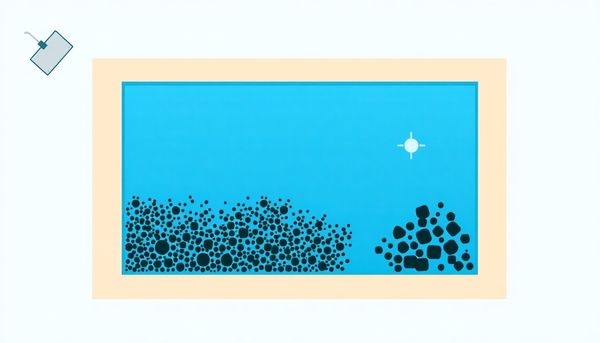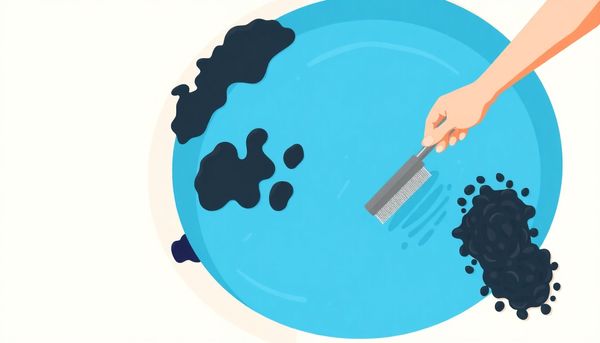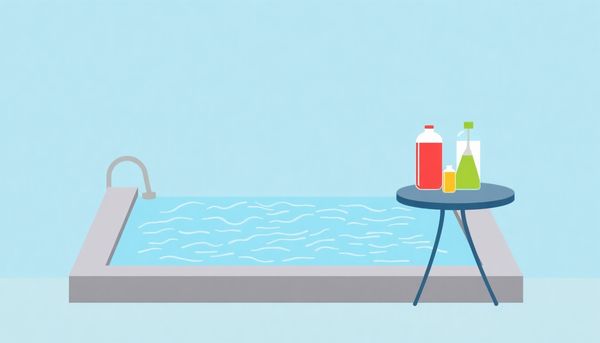Mastering Black Algae: Effective Pool Cleaning Tips
April 20th, 2024
April 20th, 2024
The allure of a sparkling, blue pool can easily be overshadowed by the ominous presence of black algae. Resilient and unwelcome, these invaders latch onto surfaces, making them a nuisance for pool owners. Unlike more common forms of algae, black algae are particularly stubborn, their roots digging deep into plaster and concrete, creating a stronghold that requires more than mere elbow grease to eradicate.
Years ago, I faced a similar predicament. My backyard paradise was marred by streaks of dark, unsightly growths that refused to budge no matter the scrubbing or the frequent changes in chemical balance. The experience was both frustrating and enlightening, igniting a determination to understand these pesky organisms. What I learned was a blend of chemistry, persistence, and a touch of strategy.
The battle against black algae is not just about warfare with chlorine and brushes—it's about understanding the enemy's nature. The algae form a protective layer, making them resistant to standard cleaning methods. They thrive in lackluster water conditions, often finding a haven in neglected corners or shaded areas of the pool. Armed with the right knowledge and tools, however, victory is within reach. The journey to reclaim your pool's pristine state will not only enhance your enjoyment but also preserve the health of your aquatic oasis for seasons to come.

Unwelcome little visitors can sometimes sneak into your pool, bringing with them a challenge best tackled swiftly: black algae. Identifying this pesky intruder early on can save you a heap of trouble and elbow grease later. Unlike the bright green hue of typical algae, black algae masquerades as dark, stubborn spots, resembling mold more than anything botanical. These patches can cling tenaciously to your pool’s surfaces, particularly favoring porous materials like plaster or gunite over smoother fiberglass or vinyl.
Picture yourself at the edge of your pool, scrutinizing every inch. Those tiny, black or dark green dots aren’t just dirt—they're black algae, ready to dig their roots in deeper. If left unchecked, these clumps can swell into larger blemishes, turning your pool into a veritable eyesore and potential health hazard. For instance, remember that swimming escapade in the lake last summer? It might have been the unintentional ferry for these unwelcome guests right into your pristine waters.
Another cue to watch for is the texture. While green algae tends to be slimy, black algae feels more like sandpaper. This texture is due to its protective layers, which make it so notoriously difficult to eradicate. Noticing these early signs allows you to act quickly, preventing a minor annoyance from escalating into a full-blown pool crisis. So, equip yourself with keen observation and vigilance to ensure your pool stays a clean, inviting haven for fun and relaxation.
Black algae might sound like a villainous pool invader, but it can be kept at bay with the right precautions. A proactive approach starts long before any evidence of this sneaky cyanobacteria appears. First, make it a habit to thoroughly clean anything that enters the pool. Whether it's a swimsuit worn in a lake or a float that drifted down a river, wash everything with a bleach solution—one tablespoon per gallon of water—to sanitize effectively. This simple step closes one major pathway for black algae to infiltrate your oasis.
Equally important, maintain balanced pool chemistry. Regularly testing and adjusting your pool's pH, alkalinity, and sanitizer levels creates a hostile environment for black algae. Remember, a well-balanced pool is less like a spa retreat for bacteria and more like an unwelcome setting for any microorganism hoping to make it home.
In addition, keep the pool clean by routinely scrubbing surfaces and vacuuming debris. This not only helps prevent black algae but also other unwanted growths. Schedule these tasks as part of your weekly pool maintenance, ensuring they become second nature. And don't forget to regularly check and clean your filter, as it plays a crucial role in keeping your water crystal clear.
By integrating these practices into your pool care routine, you'll transform your swimming pool into a fortress, impervious to the black algae menace. Thus, ensuring endless days of carefree swimming joy throughout the season.
When it comes to battling the elusive black algae in your pool, identifying it early is crucial. The first telltale sign of black algae is its stubborn presence on your pool surfaces, appearing as small black dots or clusters that resemble mold. Unlike regular algae, which tends to flourish on the water's surface, black algae prefers to attach itself to concrete or plaster, burrowing into these porous surfaces and setting down roots. It’s a bit like that pesky weed in your garden that refuses to go away no matter how many times you pull it out.
Interestingly, this "algae" isn't really algae at all, but rather a form of cyanobacteria. This distinction is important because it means traditional methods used for green algae won’t work here. Cyanobacteria are resilient and often display a dark blue-green hue that can be mistaken for black, especially when viewed in shaded areas or deeper parts of the pool.
If you have a fiberglass or vinyl-lined pool, you might have some reprieve, as black algae rarely adheres to these smoother surfaces. But even then, vigilance is key. The best way to spot it early is by regularly inspecting your pool’s corners, steps, and seams—favorite hiding spots for this unwelcome guest. By familiarizing yourself with these characteristics, you can act swiftly to tackle the problem before it spreads, ensuring your pool remains a safe, inviting oasis.
In the relentless battle against black algae, precision, patience, and preparation become your best allies. This isn't your run-of-the-mill pool maintenance task. Black algae, being a formidable cyanobacteria, demands a strategic approach. My neighbor once fought this aquatic nemesis for weeks before discovering the right method. The secret? A robust combination of thorough cleaning, effective chemical application, and relentless vigilance.
Start with a deep clean of your pool. Use a stiff, stainless-steel-bristled brush if your pool is concrete or plaster; for fiberglass or vinyl, opt for a gentler nylon-bristled one. Scrubbing loosens the stubborn bacteria from surfaces, making it vulnerable to the next step: chemical warfare. A trusted pool technician once shared his favorite tip—scrub with a chlorine tablet in hand. This action simultaneously loosens and treats the algae, providing a dual attack.
Next, shock the pool with calcium hypochlorite shock at four times the normal dose. Remember, timing is crucial; conduct this operation at night to avoid sunlight diminishing the chlorine's potency. Run the pump for a solid 24 hours to ensure thorough chemical distribution.
Finally, don’t forget to cleanse your filtration system again. Backwashing or rinsing ensures no lurking bacteria reinfects your hard-won clean water. This meticulous process, though demanding, transforms your pool back into the gleaming oasis it deserves to be. With dedication and the right approach, you'll outsmart the wiley black algae, ensuring it doesn't darken your waters again.

Battling black algae in your pool can feel like an epic saga, demanding time, effort, and a bit of elbow grease. The key to success lies in mastering the art of scrubbing. Begin by selecting the right tool: a stainless-steel-bristled brush for concrete or gunite pools, or a nylon-bristled one for softer surfaces like fiberglass or vinyl. This isn't just a casual sweep; it's a full-scale assault on the stubborn bacteria clinging to your pool's surfaces.
Start with a hearty breakfast because, trust me, you'll need the energy. Approach the task like a workout session, taking time to thoroughly brush every nook and cranny, especially those hard-to-reach corners where algae loves to hide. It might help to think of it as a treasure hunt, with the prize being a pristine, sparkling pool.
My own pool cleaning adventures taught me that persistence is crucial. I remember one summer, after a particularly stubborn bout of black algae, I discovered that playing some upbeat music inspired a rhythm to my scrubbing. It turned a tedious chore into something almost enjoyable. This relentless scrubbing dislodges the algae, setting the stage for the pool shock to do its magic.
After your scrubbing session, take a moment to admire your work. You've just completed a crucial step in reclaiming your pool's health. Now, with the algae loosened and vulnerable, you're ready to move on to the next phase in your pool-cleaning quest.
Ever notice how meticulous personal habits can prevent a host of unwelcome surprises? Just like washing your hands keeps germs at bay, maintaining high standards of pool hygiene is paramount in preventing the invasion of black algae. This pesky intruder thrives on neglect, making cleanliness your first line of defense.
Start with the basics: anything that comes into contact with your pool should be cleaned thoroughly. Swimwear, for instance, should never go from a lake straight into your pool. Ensure it gets a good wash in between. A buddy of mine swore his shoes were never the culprits until he realized rinsing them wasn't enough—so now he uses a bleach-based solution to clean all poolside paraphernalia.
Equally important is regular pool maintenance. Check your pool’s pH levels and sanitizer balance routinely. When I first took charge of my pool, I learned the hard way that a slip in routine meant a green tinge creeping up the walls. Regular brushing and vacuuming of your pool, even if it seems clean, wards off the bacteria that masquerade as black algae.
Also, don’t underestimate the power of circulation. Running the pool pump daily ensures water doesn’t stagnate, a condition black algae loves. Sharing these small, consistent efforts keeps your pool pristine and inviting, ensuring you and your family can enjoy it without the shadow of unwelcome guests.
Spotting black algae in your pool can feel like discovering an unwelcome guest at a summer BBQ. Unlike its green cousin, black algae isn't simply algae but a form of cyanobacteria, a hardy organism that thrives in specific conditions. Recognizing it early is crucial for effective treatment and prevention.
Start by examining the pool walls. Black algae often appear as dark spots or clumps that cling to rough surfaces like plaster or concrete. These stubborn patches resemble mold or mildew more than the typical algae, resisting even the most persistent scrubbing. While green algae can float freely or smear across surfaces, black algae roots itself into the pool's porous materials, making it notoriously difficult to eradicate.
Another oddity is the color. Despite the name, black algae isn't always uniformly black. The presence of blue-green pigments within cyanobacteria can give it a dark, yet slightly bluish hue. This deceptive appearance often leads to confusion, as it can blend seamlessly with darker pool linings, making it less noticeable until it's well established.
Pay attention to where it forms. Unlike green algae, which can appear anywhere, black algae prefer shaded areas with little water circulation, particularly around ladders, steps, and pool corners. If you spot these telltale signs, it's time to gear up for a thorough cleaning. Remember, treating black algae isn't just about restoring your pool’s appearance; it’s about ensuring a safe swimming environment for everyone involved.
When faced with the unwelcome guest of black algae in your pool, it's time to roll up your sleeves and embrace some good old-fashioned elbow grease. Intensive brushing is your first line of defense against these stubborn invaders. Unlike their green relatives, black algae form a resilient, protective layer that shields them from conventional treatments. As a result, a vigorous brushing routine is essential to break through this defense and expose the bacteria.
To start, you’ll need the right tool for the job—a stainless-steel-bristled brush for concrete or gunite pools, or a nylon-bristled brush if you have a more delicate fiberglass or vinyl liner. This isn't a task for the faint-hearted; it's more akin to scrubbing years of grime off a neglected barbecue grill. The brush needs to reach into every nook and cranny, ensuring that no algae colony remains safe from its bristles.
This thorough scrubbing dislodges the algae from the pool’s surfaces, suspending them in the water where chemical treatments can effectively target and destroy them. Remember, consistency is key. Regularly brushing your pool not only helps in eliminating current infestations but also plays a crucial role in preventing future outbreaks. By incorporating this regimen into your pool maintenance routine, you're not just cleaning; you're reclaiming your pool's pristine condition and ensuring a safe, enjoyable swimming environment for your family.

Cleaning your pool toys might not be the most thrilling part of pool maintenance, yet it plays a crucial role in keeping black algae at bay. Overlook this step, and you might find yourself facing an unwelcome invasion of these pesky cyanobacteria.
Think back to that inflatable unicorn from your last beach trip, still chilling by the poolside. Sure, it brought smiles and epic Instagram photos, but it also carried hidden baggage from the ocean—black algae spores. Ignoring such toys could easily turn your pool into a breeding ground for these stubborn invaders, undoing all your hard work in maintaining a pristine swimming experience.
To avoid this, embrace a thorough sanitization routine. Begin by preparing a cleaning solution using one tablespoon of bleach per gallon of water. This mix isn't just for aesthetics—it's your frontline defense against harmful bacteria. Scrub each toy meticulously, ensuring every nook is reached. For those hard-to-scrub crevices, a toothbrush can be surprisingly effective. Don't forget to rinse them thoroughly afterward, as lingering bleach can irritate skin and eyes.
Moreover, consider a spray cleaner with bleach as a quick alternative for the days when time is scarce. This will provide a quick cleanse but remember, thorough scrubbing is always preferable. By dedicating a little extra effort to this task, you protect not just your pool but also ensure a healthier swim for everyone.
Black algae can be a pool owner's worst nightmare, but with the right steps, you can prevent it from ever setting foot—or rather, spore—in your oasis. A critical preventative measure is ensuring that anything entering your pool is sanitized. Remember that time at the lake with your favorite inflatable swan? That swan might just be a culprit for spreading unwanted bacteria. Before anything gets a chance to float around your pool, give it a thorough wash with a bleach solution—one tablespoon per gallon of water does the trick.
Next, let's talk about swimsuits and gear. How often have you tossed your swimwear into your pool after a beach day? A quick run through the washing machine can save you hours of scrubbing and shocking later. If you’re like me, you’ve got a collection of goggles and flippers that seem to travel between pool and pond; ensure these are scrubbed clean as well.
Keeping your pool’s chemical balance in check is another line of defense. Regularly test and adjust pH, alkalinity, and sanitizer levels to create a hostile environment for algae. It’s like building an invisible fortress around your pool. By maintaining these levels, you’re not just preventing black algae but also ensuring any other potential contaminants are kept at bay.
Finally, consistent circulation and filtration are your best allies. Run your pump daily to keep water moving and filters clean. Consider investing in a high-quality filter cleaner to ensure nothing slips by. With these simple habits, your pool will remain sparkling and algae-free for seasons to come.
Spotting black algae in your pool is essential to tackling the problem before it spirals out of control. This sneaky invader, often mistaken as mere dirt or leaf debris, manifests itself as small, dark spots clinging stubbornly to your pool's surfaces. Unlike the floating green algae, black algae digs deep into porous surfaces like plaster or concrete, forming roots that make it exceptionally hard to eradicate.
On a sunny afternoon, I noticed something peculiar in my pool. Tiny black specks started appearing on the walls, and despite regular cleaning, they refused to budge. Closer inspection revealed the presence of black algae. It taught me that these spots often masquerade like mold, camouflaging in the corners or shaded areas of the pool. The texture of these spots is slightly raised and rough, which can be felt if you run your fingers over them (not recommended without gloves due to potential toxins).
You’ll also often find it in hard-to-reach places—corners, steps, and pool lights are favorite hideouts. It's quite persistent in areas that receive less sunlight, making it all the more vital to check those dim corners regularly. Recognizing these characteristics early can save you an immense amount of effort and resources in removing black algae from your beloved backyard oasis. So, keep a vigilant eye on those sneaky spots, and act swiftly if you suspect an infiltration.
Unbeknownst to many pool owners, the innocent-looking pool toys strewn across the water can be covert carriers of black algae. This sneaky intruder often hitches a ride on inflatables and other accessories, only to become a major nuisance later. Take, for instance, the time I discovered my once-pristine pool was suddenly home to stubborn black spots. After some detective work, I traced the root cause back to a colorful beach ball that had accompanied us to the lake the weekend before.
To prevent such surprises, a thorough cleaning routine for pool toys is vital. Start by preparing a simple cleaning solution: mix one tablespoon of bleach in a gallon of water. This concoction not only cleans but also effectively sanitizes. Gently scrub each toy with a soft brush or sponge, ensuring all surfaces are covered. Pay special attention to seams and crevices, as these are the favorite hiding spots for algae. Once scrubbed, rinse the toys thoroughly with fresh water to remove any bleach residue that could affect your pool's chemical balance.
Drying is the final, yet crucial, step. Ensure that all toys are fully dry before reintroducing them to the pool, as moisture can create a hospitable environment for algae spores. With these steps, you're not just cleaning toys; you're safeguarding your pool from future bacterial invasions. Keeping pool accessories algae-free requires a bit of diligence but offers peace of mind, allowing everyone to enjoy a safe and clean swimming experience.

The triumph over black algae hinges on one critical aspect: maintaining your pool’s chemical balance. When your pool's chemistry is off-kilter, it creates a welcoming environment for those unwelcome cyanobacteria guests. A lesson learned from my own backyard escapades one summer—after countless weekends spent scrubbing away that stubborn black film—was that prevention begins with balance.
Start by regularly testing your pool’s water. A good test kit will guide you in checking crucial components such as pH levels, alkalinity, and chlorine concentration. The pH should ideally hover between 7.4 and 7.6, a sweet spot that discourages algae growth while keeping swimmers comfortable. Alkalinity should rest between 80 and 120 ppm, acting as a buffer against pH fluctuations.
Once you’ve determined the current chemical levels, adjustments might be necessary. Low chlorine levels? Consider a shock treatment not only to kill existing contaminants but also to prevent future invasions. Adjusting alkalinity and pH might call for specific chemicals like sodium bicarbonate or muriatic acid, respectively.
Remember, consistency is your best ally. A weekly routine of testing and adjusting can save hours of laborious cleaning later. I learned to associate these checks with something enjoyable, like a morning coffee ritual, making it less of a chore and more of a routine. This method worked wonders for me and can do the same for you; it ensures your pool remains a refreshing oasis, free from the clutches of black algae.
The day you spot those pesky black dots clinging stubbornly to your pool's walls, it's time to spring into action. Understanding how black algae, or more accurately, cyanobacteria, sneaks into your pool is your first line of defense. Often, this unwelcome guest hitches a ride on swimwear or pool toys that have ventured into natural bodies of water. One swim in a lake, followed by a dip in your pool without a thorough rinse, can be enough for these bacteria to settle in.
Perhaps you recall that summer barbecue when everyone jumped in after a day at the beach, or maybe it was the canoe trip where you forgot to rinse out the gear. Such innocent oversight can lead to a serious infestation. Black algae are cunning—hiding in the rough textures of concrete or plaster pools, they thrive where they find a foothold. Unlike their greener cousins, which are easier to spot and manage, these bacteria are more tenacious, requiring a more aggressive approach to removal.
Moreover, the danger of cyanotoxins means that prevention isn't just about aesthetics; it's a safety concern. Clear signs of an infestation include clusters of dark spots that resemble mold more than algae. If these appear, it’s crucial to act swiftly to prevent potential health risks to anyone who might accidentally swallow contaminated water. Identifying the threat early ensures a safer, healthier swimming environment for everyone.
Tackling the problem of black algae requires more than just a casual clean-up. It's a detailed, multi-step process that demands diligence and the right tools. Begin with a thorough inspection of your pool equipment and surfaces. Black algae, mischaracterized as algae but actually cyanobacteria, roots itself deep into porous surfaces like concrete and plaster. This makes it imperative to address every nook and cranny with precision.
Start by donning your protective gear: gloves, goggles, and perhaps a hat, because you'll be spending considerable time outdoors. Armed with a stainless-steel bristle brush, or a nylon one if your pool has a vinyl or fiberglass liner, scrub the pool walls and floors. This step is crucial as it loosens the algae, making it susceptible to chemical treatment. Persistence is key; you might feel like you've gone through a rigorous workout, but remember, the goal is to dislodge every bit of this stubborn invader.
Next, it’s time to super chlorinate. Doubling or even quadrupling the usual shock dosage ensures that you’re not just giving the algae a light slap but a knockout punch. Run your pool pump continuously for 24 hours to circulate the shock thoroughly. Don’t let your guard down; brush the pool surfaces several times during this period. After a full day, clean your filter again to remove any dead bacteria remnants.
Finally, reassess your water chemistry. Ensuring the pH, alkalinity, and sanitizer levels are optimal not only supports the effectiveness of the algae eradication process but also fortifies your pool against future invasions. Keep watch over the next few weeks for any signs of resurgence, and establish a routine maintenance schedule to keep your pool algae-free.
Nobody wants to fight the same battle twice, especially when it comes to the relentless black algae in your pool. Arm yourself with prevention strategies to ensure this unwelcome guest doesn't return. After all the scrubbing, shocking, and filtering, your pool should be pristine. But vigilance is key.
Start with the basics: maintain a strict cleaning schedule. Regular brushing of your pool’s surfaces can prevent any lingering cyanobacteria from taking root again. After each swim, remind everyone to rinse swimsuits and equipment before they ever see the pool again. This simple step stops potential new spores from contaminating your water.
Think of your pool’s chemical balance as its immune system. Regularly check your water’s pH, alkalinity, and sanitizer levels. Keeping these in optimal ranges creates a hostile environment for algae growth. Consider investing in a reliable water testing kit if you haven’t already; it’s a small price to pay for peace of mind.
For an extra layer of protection, some pool owners swear by algaecides. Though not always necessary, these can provide additional security against algae. Opt for products specifically designed for black algae, and follow the instructions meticulously to ensure effectiveness.
Finally, don’t underestimate the power of fresh water. Regularly replacing a portion of your pool’s water can dilute potential contaminants and keep your pool sparkling. Remember, the best offense against black algae is a solid defense. Keep that vigilance up, and let the only thing flourishing in your backyard be your enjoyment.

There’s nothing quite like waking up to a pool that has transformed overnight, especially after battling the stubborn invader known as black algae. Once you've prepared the battlefield by brushing and scrubbing relentlessly, it’s time to unleash the secret weapon: pool shock. Unlike its green cousin, black algae is a formidable foe, demanding a more potent approach.
Start by calculating your pool's volume—a crucial step to ensure you don't under-arm your attack. After determining this, quadruple the standard shock dose. Yes, four times the normal amount! This isn't just overkill; it's a necessary strategy against this persistent bacteria.
Timing is everything. Shock your pool as the sun sets, allowing the chlorine to work unimpeded by UV rays. The stillness of night creates the perfect environment for the chemicals to penetrate and obliterate the algae. As the pump hums through the dark hours, it's not merely circulating water; it's ensuring every corner of your pool is saturated with weaponized chlorine.
By morning, you might notice a cloudy pool, but fear not—this is a sign of progress. It’s the remnants of your microbial enemies, battered and floating. For good measure, brush the pool surfaces again to dislodge any surviving algae and keep the pump running to capture the debris. The final step? Clean your filter once more. After such an exhaustive battle, it's the least you can do to secure victory.
Spotting black algae in your pool can feel like finding an uninvited guest at a party, except this guest doesn’t just leave politely. It’s crucial to know your enemy, and black algae, despite its name, is anything but ordinary algae. It masquerades as a tough opponent, mainly because it’s not a true plant-based algae but rather cyanobacteria—a form of bacteria with a reputation for tenacity.
First impressions of black algae may deceive. It appears as stubborn, dark patches clinging to your pool’s surfaces, reminiscent of mold. These aren’t just surface marks; they penetrate porous materials like concrete and plaster, embedding themselves persistently. If your pool has vinyl or fiberglass liners, you might breathe slightly easier, as these surfaces are less inviting to black algae. However, vigilance is essential as the bacteria can still find a way.
Look closely at the waterline or corners—anywhere the water is static. Those tiny black dots or clusters are telltale signs. Unlike green algae, which tends to float and spread evenly, black algae stays in place, forming colonies that resist typical cleaning efforts. Its resilience stems from a protective layer that shields it from chemicals like chlorine.
Remember, misidentifying black algae as the common green variant can lead to ineffective treatments. Understanding its unique characteristics is the first step in effectively reclaiming your pool. Arm yourself with the right knowledge, and you’re well on your way to banishing this unwelcome visitor for good.

This article provided insights into maintaining your pool. Start your pool care journey today!
Want to become a pool maintenance expert? Our free Pool School course covers everything you need to know about pool care. From basic maintenance to advanced troubleshooting, you'll learn how to:
Join over 10,000 pool owners who have already transformed their pool care routine. Get started with our free Pool School course today!